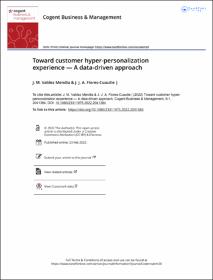| dc.contributor.author | Valdez Mendia, Jose Mauricio | |
| dc.contributor.author | Flores Cuautle, Jose de Jesus Agustin | |
| dc.date.accessioned | 2022-06-28T16:54:52Z | |
| dc.date.available | 2022-06-28T16:54:52Z | |
| dc.date.issued | 2022-02-23 | |
| dc.identifier.issn | 2331-1975 | |
| dc.identifier.uri | http://repositorios.orizaba.tecnm.mx:8080/xmlui/handle/123456789/569 | |
| dc.description | Today’s omnichannel business models incorporate physical and digital touchpoints interacting with customers. A hyper-personalization strategy relies on the organization’s capability to gather and transform customer data into personalized
experiences; therefore, when a hyper-personalization organizational plan is put in place, it serves two main functions: to deliver personalized experiences and increase the number of customers receiving such experiences. For this to happen,
four elements are required for a hyper-personalization strategy: data foundation, decisions, design, and distribution. While customer master data management relies on the correct identification of a customer, a real customer insight can only be
achieved when three types of customer data are gathered: Identity, Contactability, and Traceability (I, C, T)- fulfilling the first element of a hyper-strategy. This article aims to identify the benefits in the total number of customers that can receive
a hyper-personalization strategy when real-time touchpoints are linked to a customer Master Data Management that integrates the three types of customer data. | es |
| dc.description.abstract | Today’s omnichannel business models incorporate physical and digital touchpoints interacting with customers. A hyper-personalization strategy relies on the organization’s capability to gather and transform customer data into personalized
experiences; therefore, when a hyper-personalization organizational plan is put in place, it serves two main functions: to deliver personalized experiences and increase the number of customers receiving such experiences. For this to happen,
four elements are required for a hyper-personalization strategy: data foundation, decisions, design, and distribution. While customer master data management relies on the correct identification of a customer, a real customer insight can only be
achieved when three types of customer data are gathered: Identity, Contactability, and Traceability (I, C, T)- fulfilling the first element of a hyper-strategy. This article aims to identify the benefits in the total number of customers that can receive
a hyper-personalization strategy when real-time touchpoints are linked to a customer Master Data Management that integrates the three types of customer data. | es |
| dc.language.iso | en_US | es |
| dc.publisher | Taylor and Francis | es |
| dc.relation.ispartofseries | Cogent Business & Management; | |
| dc.subject | Big Data | es |
| dc.subject | Customer interaction | es |
| dc.subject | touchpoints | es |
| dc.subject | personalization | es |
| dc.title | Toward customer hyper-personalization experience — A data-driven approach | es |
| dc.type | Article | es |



